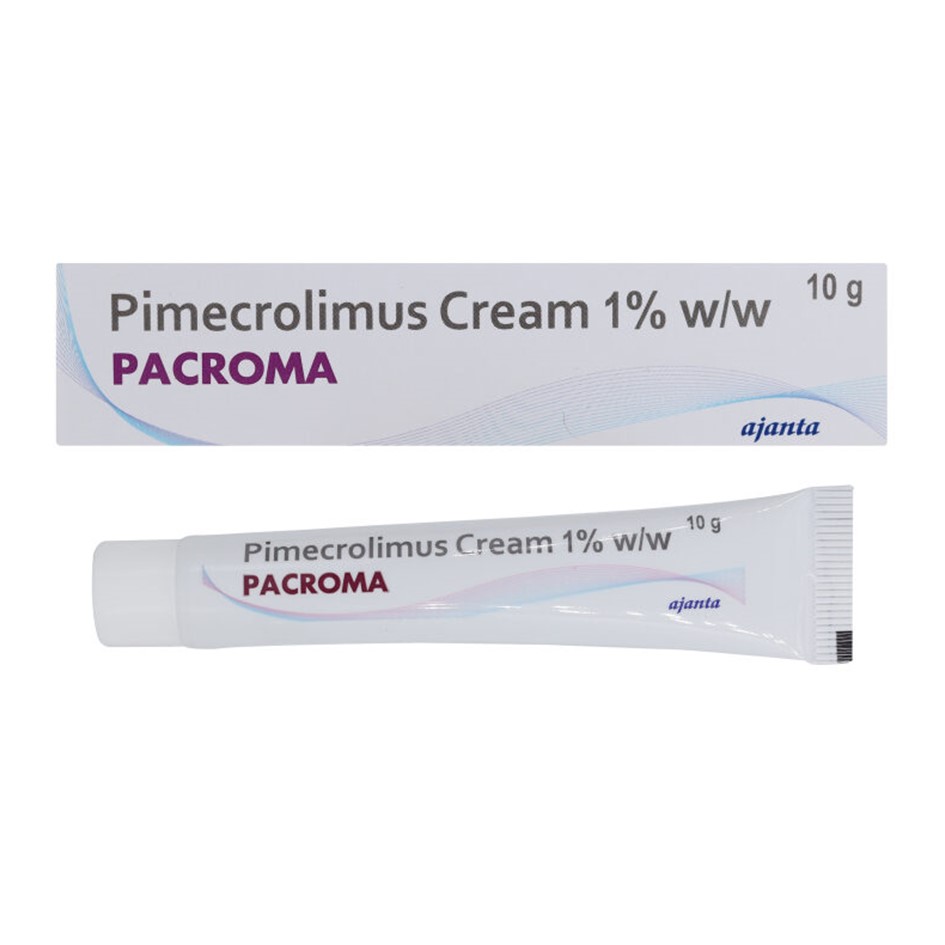Pacroma Cream 1%
| SKU | 2743 |
|---|---|
| Generic For | Elidel |
| Manufacturer | Ajanta Pharma, India |
| Active Ingredient | Pimecrolimus |
| Pack Size | Qty | Price Per Pill or Unit | Price | Cart | |
|---|---|---|---|---|---|
| 1 Tube/s | US$ 25.00 | US$ 25.00 | |||
|
|||||
| 3 Tube/s | US$ 21.67 | US$ 65.0013%US$ 75.00 | |||
|
|||||
Pacroma 1% cream is a prescription medicine used on the skin to treat early signs and symptoms of eczema (also known as atopic dermatitis), such as redness, itchiness, tiny bumps, or thickening of the skin. It is effective in treating repeated episodes of eczema. The topical treatment should be initiated as soon as the first signs of eczema appear to prevent the progression of these symptoms in terms of severity, which may only be treated with the use of a topical steroid. However, if a steroid cream is needed to treat an episode of eczema, it should be used as directed. In that case, Pacroma cream should be stopped and restarted to treat the remaining symptoms (if any) after steroid treatment has been discontinued.
Pancroma 1% is a steroid-free topical medicine that effectively treats inflammation of the skin. It contains the active ingredient Pimecrolimus 1% which functions by suppressing the activity of certain immune cells in the skin that are responsible for causing inflammation and the characteristic itching and redness associated with eczema.
Things to take care of while using Pacroma 1% Cream
Do not swallow the cream. If you do, call your dermatologist. Limit sun exposure while treating using the Pimecrolimus cream, even when the medicine is not on your skin. If it is necessary to step out in the sun after applying Pacroma 1% cream, wear loose-fitting clothes that protect the treated skin area. Ask your dermatologist about other types of sun protection measures that you can incorporate into your routine. Avoid using tanning beds, sun lamps, or receiving treatment with ultraviolet light therapy during the Pimecrolimus treatment. Don’t let the medicine get into your eyes. If Pacroma gets into your eyes, rinse your eyes with cold water. Do not apply the cream to the skin affected by active viral infections, including cold sores or chickenpox.
Avoid applying the topical medicine to your breasts while you are breastfeeding. If you have just received a vaccination, avoid applying the product to the vaccination site until the reddening of the skin and swelling have resolved. In the event of accidental application to these areas, immediately wipe it off and rinse thoroughly with water. Before using the cream, inform your dermatologist if you have had skin cancers removed or if you have any changes in your skin that may indicate a potential risk of skin cancer. Also, inform them if you have swelling of the lymph nodes, a skin infection, Netherton syndrome (a rare hereditary disorder), or a weakened immune system (for example, as a result of cancer, diabetes, HIV, or from taking medications that suppress the immune system).
Side effects of Pacroma 1% Cream
Commonly reported side effects of Pacroma 1% cream at the application site are burning or a feeling of warmth. These side effects are usually mild, occur during the first few days of treatment, and typically resolve within a few days to weeks. Contact your dermatologist if the burning sensation is severe or persists for more than a week. Other reported side effects include a common cold and a stuffy nose, fever, influenza, viral infection, cough, sore throat, and headache. Some people contract viral infections, such as chickenpox, shingles, cold sores, warts, or swollen lymph nodes.
Speak to your dermatologist if you develop a skin infection or if side effects such as swollen glands continue to be bothersome. These are not all the side effects associated with the topical medicine. Ask your dermatologist for more information.
Instructions for using Pacroma 1% Cream
Pacroma 1% is for topical use only. It should be used 2 to 4 times a day on the affected areas or used as instructed by your dermatologist. Wash your hands before handling the cream. When applying the formulation after a bath or shower, make sure your skin is dry. Use a thin layer only on the affected skin areas twice a day, exactly as instructed by your dermatologist. Dermatologists always recommend using the smallest amount of this cream required to control the signs and symptoms of eczema.
Apply the cream slowly and evenly to the skin until it is completely absorbed. You are not supposed to use it too often, and you should avoid covering the treated area with a bandage, plaster or dressing. Avoid bathing, taking a shower or swimming right after applying the medicine. This could wash off the cream and thereby its effects. You are allowed to use a moisturiser with Pimecrolimus cream. It is also important to check with your dermatologist about the cosmetic products, including moisturiser, that are right for you. Because patients with eczema have very dry skin, it is essential to maintain good skin care practices. If you are using a moisturiser, apply it after Pacroma cream. You must inform your dermatologist if there is no significant reduction in visible eczema symptoms after two weeks of topical treatment or if the skin worsens.










Login
Sign Up
Login
Sign Up